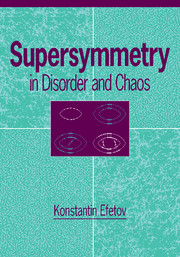Book contents
- Frontmatter
- Contents
- Preface
- Acknowledgments
- 1 Introduction
- 2 Supermathematics
- 3 Diffusion modes
- 4 Nonlinear supermatrix σ-model
- 5 Perturbation theory and renormalization group
- 6 Energy level statistics
- 7 Quantum size effects in small metal particles
- 8 Persistent currents in mesoscopic rings
- 9 Transport through mesoscopic devices
- 10 Universal parametric correlations
- 11 Localization in systems with one-dimensional geometry
- 12 Anderson metal–insulator transition
- 13 Disorder in two dimensions
- 14 Afterword
- Appendix 1 Calculation of the Jacobian
- Appendix 2 Magnetic field parametrization
- Appendix 3 Density–density correlation function at k = 0
- Appendix 4 Effective medium approximation as a saddle point
- References
- Author index
- Subject index
9 - Transport through mesoscopic devices
Published online by Cambridge University Press: 10 November 2010
- Frontmatter
- Contents
- Preface
- Acknowledgments
- 1 Introduction
- 2 Supermathematics
- 3 Diffusion modes
- 4 Nonlinear supermatrix σ-model
- 5 Perturbation theory and renormalization group
- 6 Energy level statistics
- 7 Quantum size effects in small metal particles
- 8 Persistent currents in mesoscopic rings
- 9 Transport through mesoscopic devices
- 10 Universal parametric correlations
- 11 Localization in systems with one-dimensional geometry
- 12 Anderson metal–insulator transition
- 13 Disorder in two dimensions
- 14 Afterword
- Appendix 1 Calculation of the Jacobian
- Appendix 2 Magnetic field parametrization
- Appendix 3 Density–density correlation function at k = 0
- Appendix 4 Effective medium approximation as a saddle point
- References
- Author index
- Subject index
Summary
Universal conductance fluctuations
Diffusion modes and conductance fluctuations
During the last 10–15 years study of transport through very small conductors has been a very popular topic of both theoretical and experimental research (for reviews see, e.g., Altshuler, Lee, and Webb (1991); Kirk and Reed (1992); Beenakker and van Houten (1991)). These systems are much larger (typically of the size 100–000 Å) than atomic distances, and, naturally, they cannot be considered as microscopic objects. Then, what can be special in their properties with respect to properties of macroscopic conductors? The answer is related to the quantum interference that proved to be so crucial to the localization problem. Although the conductors may contain internal defects, such disorder does not destroy the coherence of the wave functions and quantum effects can become very important, leading to completely new physical phenomena. The last two chapters were devoted to study of some exotic effects in isolated or almost isolated samples.
The quantum effects in isolated metal particles can be destroyed by inelastic scattering only. It is only at the classical limit that both elastic and inelastic scattering play equivalent roles in transport. Considering inelastic processes one should distinguish between the cases lϕ < L and lϕ > L, where lϕ is the inelastic mean free path and L is the size of the sample.
- Type
- Chapter
- Information
- Supersymmetry in Disorder and Chaos , pp. 189 - 245Publisher: Cambridge University PressPrint publication year: 1996



